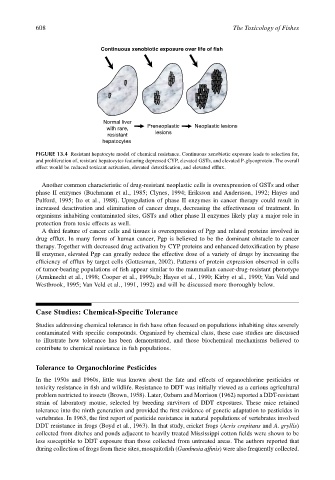Page 628 - The Toxicology of Fishes
P. 628
608 The Toxicology of Fishes
Continuous xenobiotic exposure over life of fish
Normal liver
with rare, Preneoplastic Neoplastic lesions
resistant lesions
hepatocytes
FIGURE 13.4 Resistant hepatocyte model of chemical resistance. Continuous xenobiotic exposure leads to selection for,
and proliferation of, resistant hepatocytes featuring depressed CYP, elevated GSTs, and elevated P-glycoprotein. The overall
effect would be reduced toxicant activation, elevated detoxification, and elevated efflux.
Another common characteristic of drug-resistant neoplastic cells is overexpression of GSTs and other
phase II enzymes (Buchmann et al., 1985; Clynes, 1994; Eriksson and Andersson, 1992; Hayes and
Pulford, 1995; Ito et al., 1988). Upregulation of phase II enzymes in cancer therapy could result in
increased deactivation and elimination of cancer drugs, decreasing the effectiveness of treatment. In
organisms inhabiting contaminated sites, GSTs and other phase II enzymes likely play a major role in
protection from toxic effects as well.
A third feature of cancer cells and tissues is overexpression of Pgp and related proteins involved in
drug efflux. In many forms of human cancer, Pgp is believed to be the dominant obstacle to cancer
therapy. Together with decreased drug activation by CYP proteins and enhanced detoxification by phase
II enzymes, elevated Pgp can greatly reduce the effective dose of a variety of drugs by increasing the
efficiency of efflux by target cells (Gottesman, 2002). Patterns of protein expression observed in cells
of tumor-bearing populations of fish appear similar to the mammalian cancer-drug-resistant phenotype
(Armknecht et al., 1998; Cooper et al., 1999a,b; Hayes et al., 1990; Kirby et al., 1990; Van Veld and
Westbrook, 1995; Van Veld et al., 1991, 1992) and will be discussed more thoroughly below.
Case Studies: Chemical-Specific Tolerance
Studies addressing chemical tolerance in fish have often focused on populations inhabiting sites severely
contaminated with specific compounds. Organized by chemical class, these case studies are discussed
to illustrate how tolerance has been demonstrated, and those biochemical mechanisms believed to
contribute to chemical resistance in fish populations.
Tolerance to Organochlorine Pesticides
In the 1950s and 1960s, little was known about the fate and effects of organochlorine pesticides or
toxicity resistance in fish and wildlife. Resistance to DDT was initially viewed as a curious agricultural
problem restricted to insects (Brown, 1958). Later, Ozburn and Morrison (1962) reported a DDT-resistant
strain of laboratory mouse, selected by breeding survivors of DDT exposures. These mice retained
tolerance into the ninth generation and provided the first evidence of genetic adaptation to pesticides in
vertebrates. In 1963, the first report of pesticide resistance in natural populations of vertebrates involved
DDT resistance in frogs (Boyd et al., 1963). In that study, cricket frogs (Acris crepitans and A. gryllis)
collected from ditches and ponds adjacent to heavily treated Mississippi cotton fields were shown to be
less susceptible to DDT exposure than those collected from untreated areas. The authors reported that
during collection of frogs from these sites, mosquitofish (Gambusia affinis) were also frequently collected.

